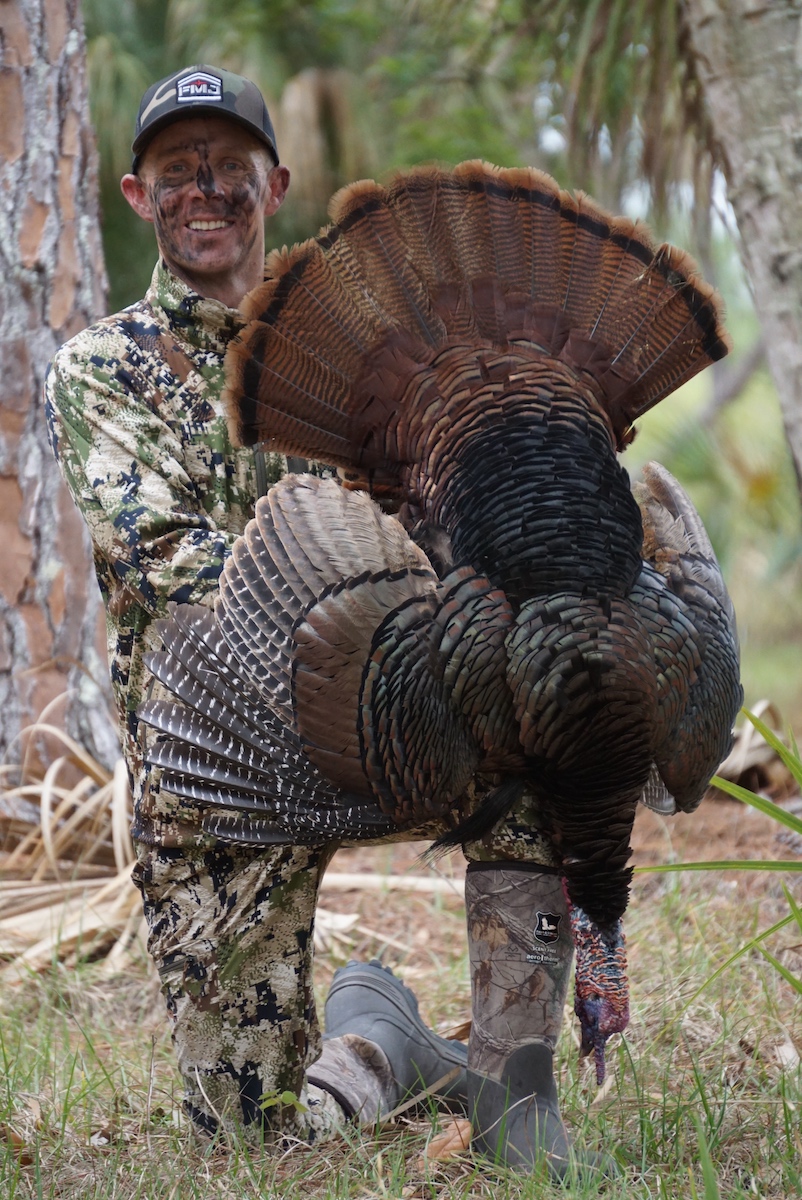Looking to make your Grand Slam Turkey run this spring, or just to add a new species to the list? I’ve been chasing wild turkeys across the country for over a decade with archery tackle, and during that time I’ve adapted a system for each particular subspecies that has proven effective time and time again. Over the next four weeks I will be reviewing some surefire recipes for success for each of the four turkey subspecies recognized by the National Wild Turkey Federation.
The Osceola 411
Named after Osceola, the famous Seminole leader, our fourth and final turkey subspecies is also commonly referred to as the Florida turkey and is found only in, well, Florida. Today, it’s estimated that roughly 100,000 Osceola turkeys inhabit the Sunshine State.
This bird is considered to be the most difficult of the four subspecies to harvest — unless, of course, you live in Florida. This is due more to the bird’s location than any other factor, and the fact that Florida doesn’t have overly robust amounts of public-land access. In addition, many who have hunted the birds say they are the most difficult subspecies to call in.
On the smaller side of the wild turkey spectrum, a mature Osceola male will push the scale to the 20-pound mark, while females typically weigh between 8 and 12 pounds. The birds have long legs, dark-brown tips on the tail feathers and mostly black wings with very small white bars or bands. The white bars are narrower and feature an irregular broken pattern, and they don’t extend all the way to the feather shaft. The Osceola also tends to have more iridescent green and reddish colors in their feathers than the Eastern subspecies.
When it comes to distribution, the NWTF and the Florida Fish and Wildlife Conservation Commission recognize any wild turkey harvested within or south of the counties of Dixie, Gilchrist, Alachua, Union, Bradford, Clay and Duval to be of the Osceola subspecies.
While the Osceola is commonly found in flat pines and oaks, it’s argued that the species prefers the Florida swamplands. These birds will eat small amphibians and other insects, but the diet of a mature Osceola bird consists mostly of plant material. Favored foods include acorns, grass, blackberries, grapes and other popular Florida plant life.
A day in the swamp
I’m by no means an Osceola expert. In fact, I didn’t even get to spend a full day in the field chasing the bird. A guest of Hoppy Kempfer’s Osceola Outfitters, I took to the Florida swamps on the last day of the state’s season. Hoppy gets booked out years in advance, and I felt blessed to even get a single day in the woods with him.
The plan was to harvest an Osceola with a bow, but Hoppy had removed all of his ground blinds in the area. So in the inky blackness of a south Florida swamp, Hoppy and I trimmed a number of palmetto branches and built a natural hide. We did hear a bit of distant gobbling on the roost, but after fly down, all went quiet. I will say that the gobbles I did hear were amazingly loud. They echoed throughout the swamp and seemed to have a booming rhythm.
Talking turkey
I’ve heard rumors that Osceola birds are difficult to call in, and I would totally agree, especially after they've pressured for over a month. The only reason I even saw a mature tom on that first setup was because of Hoppy. The man is a magician, and he called to the birds using only his mouth. No reed. No box. No pot and peg. Just Hoppy pushing his lips together making sweet turkey talk.
One wary bird
The bird slipped in silently, and before I could even begin to lift my bow, he dropped his head and bobbed away. About an hour later I caught more movement. It was a tom, and he was directly behind a large palm tree only feet from the hen decoy. He wouldn’t budge. All I could see was his beak and, occasionally, his fan. Because I had only a day to hunt, Hoppy tried handing me a 20-gauge, but the bird caught movement and disappeared.
I’ve spent piles of days in the turkey woods chasing Rio, Merriam's and Eastern birds, and I will say that the Osceola, at least in my experience, seems to have the best eyesight and is the most paranoid. I know not having a ground blind setup played a huge role in our getting busted, and so did the fact that the birds had been hunted hard for over a month, but, my goodness, are these things on edge.
On the move
After calling in the second bird and watching him slip away unscathed, Hoppy and I decided it was time to put the bow away. We were going to run and gun in the south Florida swamps.
Hoppy spotted him first, and after making a long hands-and-knees crawl to get into positon, Hoppy started calling. Again, his calling was too much for the bird to resist. Though the lone longbeard didn’t gobble or ever go into strut, he came on a string. When he was 20 yards and closing, Hoppy leaned toward me and whispered, “Bust him.”
The bird was beautiful, sporting dagger-like 1 ¼-inch spurs. In addition, his beard was paint-brush thick and pushed the tape past the 10-inch mark. Hoppy and I were thrilled. The bird completed my Grand Slam run, and though I didn’t harvest him with a bow, I wasn’t at all disappointed. I will be back. I will bring my bow. Oh, and I will enlist the help of Hoppy once again.
If you’re like me and the last bird you need for your Grand Slam run is the Osceola, I highly recommend dropping Hoppy a line at (407) 957-3593. Hoppy is a true woodsman, and when it comes to turkeys, I swear the man is half Osceola.






